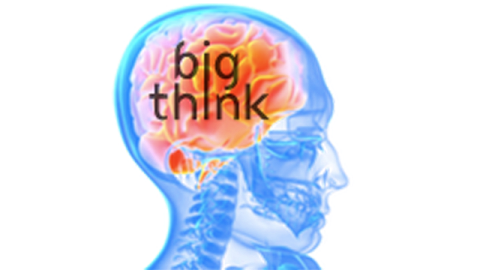September Is Big Think’s “The Month of Going Mental”

The bottle of wine you and your partner shared last night didn’t kill a single neuron in your head and, contrary to what you’ve been told, you are always using more than 10 percent of your brain. The prevalence of these myths, debunked by Princeton neuroscientist Sam Wang in the video below, prove that though we may be using our minds all the time, the public’s understanding of the spongy organ between our ears is still far from complete.
Therefore, in an effort to showcase all that cutting-edge science has discovered about the brain—and all that continues to confound—Big Think is proud to present The Month of Going Mental. Throughout September, Big Think will travel inside our heads, presenting a different feature on the brain each weekday in our new blog called Going Mental. These features will take us from unsolved mental mysteries to the latest breakthroughs in brain research. Every idea in the series will be supported by contributions from leading experts, including neuroscience giants like Antonio Damasio, Jospeh LeDoux, Oliver Sacks, and Stephen Pinker, and every week will focus on a new topic within the expansive field.
WEEK 1: The Brain’s Biggest Mysteries
Neurologists and neuroscientists alike continue to ponder age-old questions about the mind and brain. What is consciousness?What is intelligence?Why do we sleep and dream? To kick off the first week of The Month of Going Mental, Big Think will examine these three greatest mysteries of the mind.
WEEK 2: Abnormal Minds
Before neuroscientists had sophisticated brain-imaging technology, the only way they could learn about the healthy brain was to study damaged or abnormal brains. So aside from being inherently titillating, abnormal psychology has been fundamental to scientists’ understanding about the brain. Beginning with the iconic case of Phineas Gage, the second week of The Month of Going Mental will delve into the fascinating world of abnormal psychology, including schizophrenia, psychopathy, and other bizarre disorders of the mind.
WEEK 3: Sex, Drugs, and Neuroscience
This is your brain under the influence—of love, lust, drugs, and religion. The third week of Big Think’s The Month of Going Mental will reveal the way the brain’s functioning perpetuates religion; the way falling in love amounts to a series of chemical reactions inside our head; and the way that mind-altering substances distort our perception of reality.
WEEK 4: Brainstorms
The fourth week of Big Think’s The Month of Going Mental will focus on five of the most fundamental mechanisms of the brain: emotion, memory, decision-making, attention, and language. How do the different areas of the brain give rise to these fascinatingly complex phenomena? This week we will discuss what neuroscientists know up to this point about these mechanisms and also what direction the cutting-edge research is heading.
WEEK 5: Enhancing Your Brain
Modern life taxes the brain in ways it was not taxed mere decades ago. In the final week of The Month of Going Mental we will examine how our brain is coping with the changes of the digital age and what you can do to enhance your mind now and for the future.





